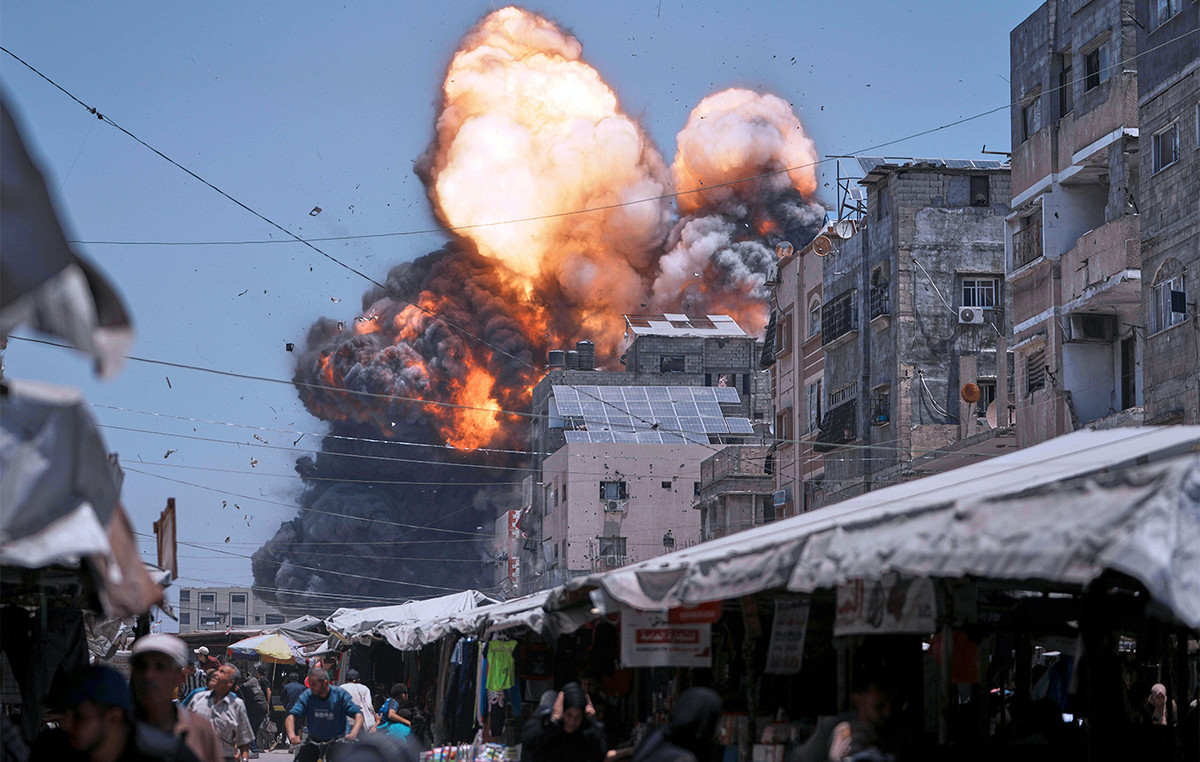There is a loud buzzing sound as a small silhouette approaches in the air. The noise is eerily reminiscent of Russian drone strikes in Ukraine, but that episode was recorded closer to Moscow than Kiev.
“They are flying straight towards us,” a woman can be heard speaking in Russian, in a video shared on social media and analyzed by CNN . As the object approaches, it becomes clear: it is a Ukrainian drone flying over Russian territory. “I’m really scared,” she says.
Another video, recorded moments later, shows the same drone turning left as air raid sirens drown out the propeller noise. Seconds later, the drone plunges from the sky, crashing into a pipe-covered tower at a Russian oil refinery, exploding on impact.
A CNN geolocated the videos at Rosneft's Ryazan refinery – one of the largest in Russia – more than 500 kilometers away from Ukraine. The March 13 attack, one of several at this facility alone, was part of a concerted effort by Ukraine to target Russian oil refineries with long-range drones.
And the efforts show no sign of the country relenting. On Tuesday (2), a Ukrainian drone hit the Niznekamsk oil refinery – one of the five largest in Russia – in the Tatarstan region, more than 1,100 kilometers from the border. At least 12 people were injured in the attack, which caused a fire at the primary refining unit, according to Russian authorities.
A Ukrainian source with knowledge of the operation told CNN that Tuesday’s attack was “one of the deepest operations into Russian territory.”
These bold Ukrainian attacks are hitting Russia's massive oil and gas industry, which, despite Western import bans and price caps, remains the biggest source of revenue for Moscow's war economy.
The attacks were made possible by the use of drones with greater range and more advanced capabilities, some of which have even begun to integrate a basic form of artificial intelligence to help them navigate and avoid being jammed, said a source close to the US drone program. Ukraine.
“Accuracy under interference is made possible by the use of artificial intelligence. Each aircraft has a terminal computer with satellite and terrain data,” explained the source close to the drone program. “Flights are determined in advance with our allies and aircraft follow the flight plan to allow us to hit targets with meters of precision.”

This precision is possible thanks to the drone's sensors.
“They have this thing called 'machine vision,' which is a form of artificial intelligence. Basically you take a model and put it on a chip and train that model to identify the geography and target that it is navigating to,” said Noah Sylvia, research analyst at the Royal United Services Institute, a UK-based think tank. . “When it’s finally deployed, it’s able to identify where it is.”
“It does not require any communication (with satellites), it is completely autonomous,” added Sylvia.
Chris Lincoln-Jones, a former British military officer and expert on drone warfare and artificial intelligence, said the level of “intelligence” was still very low. “This level of autonomy has not been seen in drones before, but we are still in the early stages of the potential of this technology,” he told CNN .
A CNN contacted Ukrainian Defense Intelligence and the Security Service of Ukraine (SBU), but neither of them would comment on the use of AI technology.
“Defund the Russian war machine”
Ukraine's use of drones is not new. The country has depended heavily on them since the start of the large-scale invasion of Russia on February 22, 2022, and has accumulated resources to advance technology and national production.
At first, Kiev mainly used commercially available equipment, either for surveillance or ingeniously adapted on the ground to launch small bombs. But it has since built a fully-fledged drone industry, giving it a technological advantage to face Russia's significantly larger workforce and better-prepared industrial apparatus.
This also explains Kiev's increasing precision, visible in these attacks on refineries, where Ukrainian forces made a point of targeting a specific area, maximizing the impact of these attacks.

Several experts contacted by CNN stated that instead of targeting fuel storage facilities, for example, Ukraine was targeting distillation units, where crude oil is processed and turned into fuel or other derivatives.
“From what we’ve seen, some of them are impressive targets that need a lot of Western technology and Russia has a much harder time acquiring that technology,” Sylvia said.
This approach gives Kiev more bang for the buck, hurting more than just randomly attacking refineries. And the markets are taking notice.
“We really see this as a shift in Ukrainian tactics to try to defund the Russian war machine,” said Helima Croft, managing director and global head of raw materials strategy at investment bank RBC Capital Markets.
Experts believe these attacks could have a greater impact on the Russian economy than the current sanctions.
“If you think about the sanctions that have been implemented so far, they have largely bypassed energy,” Croft explained. “It was really the exports of energy, crude oil, natural gas and refined products, that gave Russia the economic lifeline to continue this war.”
Ukraine says 12% of Russian refining capacity is now offline, while Reuters estimates it to be up to 14%. Russia admitted that part of its refining capacity is reduced and temporarily banned gasoline exports to avoid a rise in domestic fuel prices.

“These weeks have demonstrated to many that the Russian war machine has vulnerabilities that we can target with our weapons,” Ukrainian President Volodymyr Zelensky said after a series of such attacks.
“What our own drones are capable of is a true Ukrainian long-range capability. Ukraine will now always have a strike force in the sky.”
Ukrainian determination, American concerns
Ukrainian attacks on refineries have sent global oil prices soaring, with Brent crude rising nearly 13% this year, leaving politicians in the United States concerned about its potential economic impact in a key election year.
While not mentioning energy prices, officials in Washington said they are actively discouraging Ukraine from attacking these refineries. “We have long said that we do not encourage or allow attacks inside Russia,” an official told CNN .
Croft said US and international sanctions imposed since the start of the war were structured to keep Russian energy on the markets.

“That was the deal with Ukraine: we'll give you money, we'll give you weapons, but stay away from export facilities, stay away from Russian energy, because we don't want a massive energy crisis,” Croft explained.
But the impasse in Washington over funding for Ukraine and the potential for a change in the White House next year could give Kiev some room for maneuver.
“If they are not receiving the weapons and money they were promised, what is the incentive to fulfill the agreement with Washington?” Croft said.
A bigger concern, experts say, is that Ukraine doesn't limit itself to refineries. Some of Russia's largest oil ports, responsible for about two-thirds of its exports of crude oil and petroleum products, according to RBC, are within range of Ukraine's drones.
“If we had simply hit a large export facility, I think the impact on markets would have been substantial,” Croft said. “Many of these export facilities are adjacent to refineries, and for now it seems like a deliberate targeting to go after the refineries.”
Ukrainian officials have acknowledged U.S. concerns but say attacks will continue. “Of course we have to minimize these budget revenues as much as possible and automatically cut off Mr. Putler's oxygen,” said Vasyl Maliuk, head of the SBU, using a combination of Putin's and Hitler's names common in Ukraine.
“Therefore, we will continue to work, while the country of gas stations continues to burn,” he added.
*With information from Paul Murphy, Natasha Bertrand, Olga Voitovych, Victoria Butenko and Radina Gigova, from CNN.
Source: CNN Brasil
Bruce Belcher is a seasoned author with over 5 years of experience in world news. He writes for online news websites and provides in-depth analysis on the world stock market. Bruce is known for his insightful perspectives and commitment to keeping the public informed.







